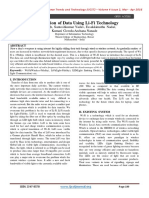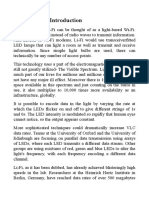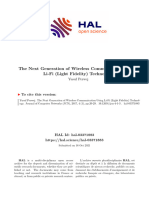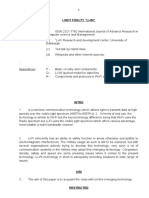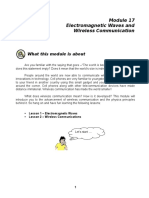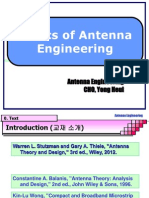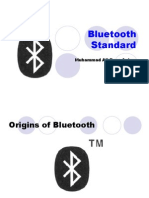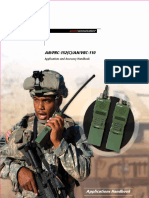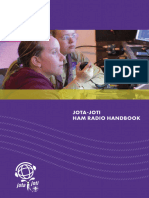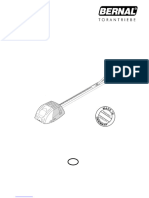Lifi: Conceptions, Misconceptions and Opportunities: Wj4.1 (Plenary) 3:30 PM - 4:15 PM
Lifi: Conceptions, Misconceptions and Opportunities: Wj4.1 (Plenary) 3:30 PM - 4:15 PM
Uploaded by
Sreekar ReddyCopyright:
Available Formats
Lifi: Conceptions, Misconceptions and Opportunities: Wj4.1 (Plenary) 3:30 PM - 4:15 PM
Lifi: Conceptions, Misconceptions and Opportunities: Wj4.1 (Plenary) 3:30 PM - 4:15 PM
Uploaded by
Sreekar ReddyOriginal Title
Copyright
Available Formats
Share this document
Did you find this document useful?
Is this content inappropriate?
Copyright:
Available Formats
Lifi: Conceptions, Misconceptions and Opportunities: Wj4.1 (Plenary) 3:30 PM - 4:15 PM
Lifi: Conceptions, Misconceptions and Opportunities: Wj4.1 (Plenary) 3:30 PM - 4:15 PM
Uploaded by
Sreekar ReddyCopyright:
Available Formats
WJ4.
1 (Plenary)
3:30 PM - 4:15 PM
LiFi: Conceptions, Misconceptions and Opportunities
Harald Haas
LiFi Research and Development Centre, The University of Edinburgh, Edinburgh EH9 3JL, UK,
h.haas@ed.ac.uk
Abstract In this talk we will first explain what Light-Fidelity (LiFi) is and highlight the key differences
to visible light communication (VLC). We will discuss misconceptions and illustrate the potential impact
this technology can have across a number of existing and emerging industries.
LiFi Conceptions
It is forecast that by 2020, we will generate
44 zettabytes of data. This amounts to nearly as
many bits on the planet as stars in the universe.
A vast amount of this data will be generated by
machines. In this context, it is forecast that by
2020, there will be 80 billion Internet-of-Things
(IoT) devices. Take a wind turbine for example.
A wind turbine currently already creates 10 ter-
abytes of data per day. A lot of this digital data
is transmitted from a source to a receiver across Fig. 1: LiFi is an additional wireless networking layer
large distances, and this end-to-end communica- complementing existing heterogeneous RF networking
technologies such as Long Term Evolution (LTE), and
tion very often involves a wireless link. In the past,
Wireless-Fidelity (WiFi). In LiFi every LED light source acts
resources to achieve wireless connectivity have as an access point (AP) for bi-directional networked wireless
been taken from the radio frequency (RF) spec- multiuser communication indoors, but also outdoors. The
trum. These are the electromagnetic frequencies high density of light sources is exploited to achieve orders of
magnitude improvements in data density. Since light does not
of up to 300 GHz. The generally accepted expo-
propagate through opaque walls and objects, physical layer
nential increase in data volumes during the next security is enhanced massively. (Photo courtesy of pureLiFi).
decade will make it increasingly difficult to provide
enough RF resources. At this point it is helpful advent of power over ethernet (PoE) and its use
to recognize that the electromagnetic spectrum is in lighting, there exists the opportunity to piggy-
much larger. There are 300 THz (1000 times the back on existing data network infrastructures for
300 GHz RF spectrum!) unused bandwidth avail- the required backhaul connections between the
able at higher frequencies in the visible light spec- light sources with its integrated LiFi modem and
trum. These resources can be used for data com- the Internet.
munication which has been successfully demon-
strated for decades in fibre optic communication LiFi Misconceptions
using coherent light communication links enabled Misconceptions about LiFi can be addressed as
by lasers. follows:
With the advent of the high brightness light LiFi is a line-of-sight (LoS) technology
emitting diode (LED), which produces incoherent This perhaps is the greatest misconception. By
light, it is logical to consider the light spectrum using an orthogonal frequency division multiplex-
for pervasive wireless communication which can ing (OFDM)-type intensity modulation (IM)/direct
be achieved with LiFi, a technology first coined detection (DD) modulation scheme 1 , the data
in 2 . LiFi extends the concept of visible light com- rate scales with the achieved signal-to-noise ra-
munication (VLC) to achieve high speed, secure, tio (SNR) 4 . In a typical office room environment
bi-directional and fully networked wireless com- where the minimum level of illumination for read-
munications 3 , and this is illustrated in Fig. 1. It ing purposes is 500 lux, the SNR at table height
is important to note that LiFi supports user mo- is between 40 dB and 60 dB. This means higher
bility and multiuser access. The key advantages order digital modulation schemes can be used in
of a LiFi wireless networking layer are: i) three conjunction with OFDM to harness the available
orders of magnitude enhanced data densities; ii) channel capacity. By using adaptive modulation
unique properties to enhance physical layer secu- and coding (AMC) it is possible to transmit data at
rity; iii) three order of magnitude improvements in SNRs as low as -6 dB. This means signal block-
energy efficiency; iv) use in intrinsically safe en- ages between 46 dB - 66 dB can be tolerated.
vironments such as petrochemical plants and oil Fig. 2 illustrates a video transmission to the lap-
platforms where RF is often banned; v) with the top in the foreground over a distance of about 3 m
978-1-5090-1906-9/16/$31.00 2016 IEEE 680
data at a speed of 1.1 Gbps over a distance of
10 m with an LED of merely 4.5 mW optical out-
put power.
LiFi Opportunities
LiFi is a disruptive technology that is poised to
impact a large number of industries. LiFi can un-
lock the IoT, drive Industry 4.0 applications, en-
able light as a service (LaaS) in the lighting in-
dustry, contribute to the 5th generation of cel-
Fig. 2: LiFi video transmission in a strictly lular systems (5G) and beyond, enable new in-
non-line-of-sight (NLoS) scenario. A LiFi AP in the
telligent transport systems, enhance road safety
background directly connects to an off-the-shelf LED light
fixture. The LED lamp streams a video to a LiFi modem in the when there are more and more driverless cars,
foreground which is connected via a universal serial create new cyber-secure wireless networks, en-
bus (USB) connection to the laptop positioned at the front. able new ways of health monitoring of aging soci-
eties, and offer new solutions to close the digital
where the LED light fixture is pointing towards a divide.
white wall in the opposite direction to the loca- LiFi will have a catalytic effect for the merger of
tion of the receiver. Therefore, there is no direct two major industries: i) the wireless communica-
LoS component reaching the receiver in the fore- tions industry, and ii) the lighting industry. In 25
ground, but the video is successfully received. years from now the LED lightbulb will serve thou-
LiFi does not work in sunlight conditions sands of applications and will be an integral part
Sunlight constitutes a constant interfering signal of the emerging smart cities, smart homes and
outside the bandwidth used for data modulation. the IoT, and LaaS will be a dominating theme in
LiFi operates at frequencies typically greater than the lighting industry which will drive the required
1 MHz. Therefore, the constant sunlight is sim- new business models when LED lamps last 20
ply filtered out, and has no impact on the bit error and more years. LaaS in combination with LiFi
ratio (BER) performance as long as the receiver will, therefore, provide a business model driven
is not saturated. This has been shown in exper- pull for the lighting industry to enter what has tra-
imental studies with commercial LiFi equipment ditionally been a wireless communications mar-
from pureLiFi. Saturation can be avoided by using ket.
automatic gain control algorithms. So on the con-
trary, we assert that sunlight is hugely beneficial Acknowledgements
as it enables solar cell based LiFi receivers where The author acknowledges support from the
the solar cell acts as data receiver device, and at EPSRC under Established Career Fellowship,
the same time harvests sunlight as energy 6 . EP/K008757/1, and the UPVLC programm grant,
Lights cannot be dimmed There are ad- EP/K00042X/1.
vanced modulation techniques such as enhanced
unipolar OFDM (eU-OFDM) 5 which enable the References
[1] M. Z. Afgani, H. Haas, H. Elgala, and D. Knipp. Visi-
operation of LiFi close to the turn-on voltage (ToV) ble Light Communication using OFDM. In International
of the LED which means that the lights can be op- Conference on Testbeds and Research Infrastructures for
erated at very low light output levels while main- the Development of Networks and Communities, 2006.
taining high data rates. TRIDENTCOM 2006., pages 6 pp. 134, 2006.
[2] H. Haas. Wireless Data from Every Light Bulb. TED Web-
The lights flicker The lowest frequency at site, Aug. 2011.
which the lights are modulated is in the region of [3] H. Haas, L. Yin, Y. Wang, and C. Chen. What is
1 MHz. The refresh rate of computer screens is LiFi? Journal of Lightwave Technology, 34(6):15331544,
about 100 Hz. This means the flicker-rate of a March 2016.
[4] D. Tsonev, H. Chun, S. Rajbhandari, J. McKendry,
LiFi light bulb is 10,000 higher than that of a com- S. Videv, E. Gu, M. Haji, S. Watson, A. Kelly, G. Faulkner,
puter screen. This means there is no perceived M. Dawson, H. Haas, and D. OBrien. A 3-Gb/s Single-
flicker. LED OFDM-Based Wireless VLC Link Using a Gallium Ni-
LiFi is for downlink only A key advantage tride LED. IEEE Photon. Technol. Lett., 26(7):637640,
Apr. 2014.
is that LiFi can be combined with LED illumina- [5] D. Tsonev, S. Videv, and H. Haas. Unlocking spec-
tion. This, however, does not mean that both func- tral efficiency in intensity modulation and direct detec-
tionalities always have to be used together. Both tion systems. IEEE Journal on Selected Areas in
Communications, 33(9):17581770, Sept 2015.
functions can easily be separated (please see the
[6] Z. Wang, D. Tsonev, S. Videv, and H. Haas. On the
comment on dimming). As a result, LiFi can also Design of a Solar-Panel Receiver for Optical Wireless
be used very effectively for uplink communication Communications With Simultaneous Energy Harvesting.
where lighting is not required. The infrared spec- IEEE Journal on Selected Areas in Communications,
33(8):16121623, Aug 2015.
trum, therefore, lends itself perfectly for the uplink.
We have conducted an experiment where we sent
681
You might also like
- Operator Manual: BMS-2 SystemDocument21 pagesOperator Manual: BMS-2 SystemHaitham Mohamed100% (2)
- Journal PaperDocument5 pagesJournal PaperSharath HnNo ratings yet
- Karanlifi ReportDocument25 pagesKaranlifi Reportkaransingh29102003No ratings yet
- LiFi Networks - Concept, Standardization Activities and PerspectivesDocument4 pagesLiFi Networks - Concept, Standardization Activities and PerspectivesMilica PopadicNo ratings yet
- Li Fi Seminar Report 5Document38 pagesLi Fi Seminar Report 5Saipavan ,R E-30No ratings yet
- A Review Paper On Li Fi TechnologDocument5 pagesA Review Paper On Li Fi TechnologNaga AdityaNo ratings yet
- Li-Fi (Light Fidelity) - A New Paradigm in Wireless CommunicationDocument5 pagesLi-Fi (Light Fidelity) - A New Paradigm in Wireless CommunicationPoonam GojeNo ratings yet
- UjjwalAggarwal (MW Case Study) PDFDocument6 pagesUjjwalAggarwal (MW Case Study) PDFUjjwal AggarwalNo ratings yet
- Transmission of Data Using Li-Fi TechnologyDocument4 pagesTransmission of Data Using Li-Fi TechnologyAnonymous 8jFcogqgSlNo ratings yet
- Project ReportDocument21 pagesProject ReportZainNo ratings yet
- 3385 Li-Fi TechnologyDocument20 pages3385 Li-Fi TechnologyMr. GyanprakashNo ratings yet
- Text Data Transfer Using Li-Fi CommunicationDocument4 pagesText Data Transfer Using Li-Fi CommunicationInternational Journal of Innovative Science and Research TechnologyNo ratings yet
- Li-Fi Technology in Wireless Communication: M.Thanigavel M .Tech CSE DEPTDocument7 pagesLi-Fi Technology in Wireless Communication: M.Thanigavel M .Tech CSE DEPTpriyank0203No ratings yet
- Lifi 50% ReportDocument33 pagesLifi 50% ReportPooja BanNo ratings yet
- Survey and Challenges of Li-Fi With Comparison of Wi-Fi: March 2016Document5 pagesSurvey and Challenges of Li-Fi With Comparison of Wi-Fi: March 2016Naidan DensmaaNo ratings yet
- Git-Cse: 1.1 MotivationDocument18 pagesGit-Cse: 1.1 MotivationNagaseshuNo ratings yet
- Overview of Li-Fi Technology: Related PapersDocument6 pagesOverview of Li-Fi Technology: Related Papersan ToNo ratings yet
- Li - Fi Department of Computer ScienceDocument23 pagesLi - Fi Department of Computer ScienceMountsinai Csc0% (1)
- Transmission of Data, Audio Signal and Text Using Li-FiDocument8 pagesTransmission of Data, Audio Signal and Text Using Li-FiMohd NaimNo ratings yet
- LifiDocument19 pagesLifiLewi WadaNo ratings yet
- LiFi Project ReportDocument24 pagesLiFi Project ReportSandhya SinghNo ratings yet
- Lifi Technology Seminar Report 35 (1) - 1Document18 pagesLifi Technology Seminar Report 35 (1) - 1George RyanNo ratings yet
- Main Di LifiDocument30 pagesMain Di Lifigopi thatipamulaNo ratings yet
- Blue Gradients Basic Simple Presentation1Document16 pagesBlue Gradients Basic Simple Presentation1Kanika RajputNo ratings yet
- Leveraging Light-Fidelity For Internet of Light State-Of-The-Art and Research ChallengesDocument6 pagesLeveraging Light-Fidelity For Internet of Light State-Of-The-Art and Research ChallengesMilica PopadicNo ratings yet
- Lifi TechnologyDocument7 pagesLifi TechnologyRNo ratings yet
- Seminar ReportDocument41 pagesSeminar ReportROHIT CHANDRASHEKHAR KUPPELURNo ratings yet
- Li-Fi (Light Fidelity) The Future Technology in Wireless CommunicationDocument10 pagesLi-Fi (Light Fidelity) The Future Technology in Wireless CommunicationrkNo ratings yet
- Li-Fi (Light Fidelity) - The Changing Scenario of Wireless CommunicationDocument4 pagesLi-Fi (Light Fidelity) - The Changing Scenario of Wireless Communicationandrewsiby63No ratings yet
- Term Paper On Li-Fi Comparing It With Wi-Fi PDFDocument11 pagesTerm Paper On Li-Fi Comparing It With Wi-Fi PDFtalim khanNo ratings yet
- ET B2 EDI-EiDocument7 pagesET B2 EDI-EiJADHAV KAUSHALNo ratings yet
- Li Fi PDFDocument38 pagesLi Fi PDFAnugraha K Mohanan100% (1)
- English LabDocument5 pagesEnglish LabSANTHOSH DHANASEKARANNo ratings yet
- Lifi Study Paper - ApprovedDocument19 pagesLifi Study Paper - ApprovedrahulNo ratings yet
- Researchpaper Li Fi Light Fidelity LED Based AlternativeDocument4 pagesResearchpaper Li Fi Light Fidelity LED Based AlternativeAseena AiamanNo ratings yet
- Lifi DocumentationDocument14 pagesLifi Documentationsumit singh100% (1)
- LiFi Seminar ReportDocument18 pagesLiFi Seminar Reportakash rawatNo ratings yet
- The Next Generation of Wireless Communication Using Li-Fi (Light Fidelity) TechnologyDocument11 pagesThe Next Generation of Wireless Communication Using Li-Fi (Light Fidelity) TechnologyMilena VukovicNo ratings yet
- LifiDocument3 pagesLifiminecraftusamaNo ratings yet
- Lifi PaperDocument12 pagesLifi PaperFalcon PratapNo ratings yet
- Fin Irjmets1699453857Document4 pagesFin Irjmets1699453857chauhan13106No ratings yet
- LI FI ReportDocument19 pagesLI FI ReportAmbuj MauryaNo ratings yet
- Seminar Report: Department: Computer Science SESSION YEAR: 2018-19Document20 pagesSeminar Report: Department: Computer Science SESSION YEAR: 2018-19gourav sharma786No ratings yet
- Lifi DocumentationpdfDocument22 pagesLifi Documentationpdfshubhamsheta5No ratings yet
- Li - Fi - SEMINAR - REPORT 2Document28 pagesLi - Fi - SEMINAR - REPORT 2rushabhjagdaleofficialNo ratings yet
- 3 LITERATURE SURVEY of Lifi TechnologyDocument4 pages3 LITERATURE SURVEY of Lifi Technologymac100% (2)
- A Presentation On For The Partial Fulfillment of The Requirement For The Degree of Bachelor of Technology in Computer Science and EngineeringDocument29 pagesA Presentation On For The Partial Fulfillment of The Requirement For The Degree of Bachelor of Technology in Computer Science and EngineeringFlask TutorialNo ratings yet
- Steven Seminar CSC 400l-1Document18 pagesSteven Seminar CSC 400l-1ifizon williamNo ratings yet
- Li FiDocument6 pagesLi FiRakesh ChinthalaNo ratings yet
- LI-FI The Latest Technology in WirelessDocument4 pagesLI-FI The Latest Technology in Wirelesswinnerman1985No ratings yet
- LI-FI The Latest Technology in WirelessDocument4 pagesLI-FI The Latest Technology in WirelessAnonymous p0bBEKNo ratings yet
- Proceedings of Spie: Light Fidelity (Li-Fi) : Towards All-Optical NetworkingDocument11 pagesProceedings of Spie: Light Fidelity (Li-Fi) : Towards All-Optical NetworkingMD TOWHIDUL ISLAMNo ratings yet
- Lifi Miniproject Sem VDocument12 pagesLifi Miniproject Sem Vay98244No ratings yet
- Serial and Parallel Data Transmission Through Li-FiDocument5 pagesSerial and Parallel Data Transmission Through Li-FibelaoufamiraNo ratings yet
- Li-Fi TechnologyDocument2 pagesLi-Fi TechnologyselvakumargeorgeNo ratings yet
- Methodology To Achieve Enhanced Data TransmissionDocument5 pagesMethodology To Achieve Enhanced Data TransmissionrakshitakabburNo ratings yet
- Final Year Project ReportDocument48 pagesFinal Year Project ReportjenishaNo ratings yet
- Li FiDocument32 pagesLi FiPREM SAI POLAPALANo ratings yet
- Wireless Communication Using Li-FiDocument9 pagesWireless Communication Using Li-FiMukesh KumarNo ratings yet
- Understanding WiFi Technology: A Comprehensive Guide (Second Edition)From EverandUnderstanding WiFi Technology: A Comprehensive Guide (Second Edition)No ratings yet
- Communication Engineering Lab ManualDocument53 pagesCommunication Engineering Lab Manualtharunkumarreddy100% (1)
- Module 17 Wireless CommunicationDocument30 pagesModule 17 Wireless CommunicationAnti VirusNo ratings yet
- Overview of Telecom NewDocument127 pagesOverview of Telecom NewGabrielNo ratings yet
- Chapter 14 - Life Labs 1950's Pad Instrument Without Ray Tube.Document2 pagesChapter 14 - Life Labs 1950's Pad Instrument Without Ray Tube.Khalid IbrahimNo ratings yet
- LG XC102 - HiFi LinijaDocument12 pagesLG XC102 - HiFi LinijaAlen LalicNo ratings yet
- UD06175B - Baseline - Video Intercom V Series Door Station User Manual - V1.4.23 - 20170624 PDFDocument87 pagesUD06175B - Baseline - Video Intercom V Series Door Station User Manual - V1.4.23 - 20170624 PDFsaom09No ratings yet
- On The Mutual Information and Precoding For SM With Finite AlphabetDocument4 pagesOn The Mutual Information and Precoding For SM With Finite AlphabetJosé Clair Menezes JúniorNo ratings yet
- Basis of Comparison Sdma Tdma Fdma Cdma Idea: Q1 Page 2-19 Q2Document6 pagesBasis of Comparison Sdma Tdma Fdma Cdma Idea: Q1 Page 2-19 Q2ITTE05Mrunal vcetNo ratings yet
- Base Station Antenna Systems - Antenna TheoryDocument110 pagesBase Station Antenna Systems - Antenna Theoryabhijeetfamt100% (4)
- RF ModuleDocument6 pagesRF ModuleSankula Siva SankarNo ratings yet
- Unit-3 SCR Satellite Link DesignDocument74 pagesUnit-3 SCR Satellite Link DesignVinamra KumarNo ratings yet
- 1 Basicsofantennaengineering 120210030248 Phpapp02Document28 pages1 Basicsofantennaengineering 120210030248 Phpapp02Seham RaheelNo ratings yet
- BJMC 12 Block 03Document46 pagesBJMC 12 Block 03vidhi guptaNo ratings yet
- Wireless Speed and Direction Control of DC Motor Using RF TechnologyDocument58 pagesWireless Speed and Direction Control of DC Motor Using RF Technologyuppalar196% (25)
- BaaaaaaaaaalDocument1 pageBaaaaaaaaaalReinmatthew ManansalaNo ratings yet
- Different Modulation Formats Used in Optical Communication SystemDocument4 pagesDifferent Modulation Formats Used in Optical Communication Systemruturaj rutuNo ratings yet
- Bluetooth Standard: Muhammad Ali Raza AnjumDocument45 pagesBluetooth Standard: Muhammad Ali Raza AnjumAli AhmadNo ratings yet
- GF 941Document1 pageGF 941bilardosarbine33No ratings yet
- Ra 3846Document3 pagesRa 3846RoyAndrew GarciaNo ratings yet
- RRU3936 DescriptionDocument15 pagesRRU3936 Descriptionerginbekar100% (2)
- An-PRC-152 (C) - Harris RF Communications - Harris CorporationDocument34 pagesAn-PRC-152 (C) - Harris RF Communications - Harris CorporationJessica R LattimoreNo ratings yet
- MG15HCFX Microstack HBK PDFDocument5 pagesMG15HCFX Microstack HBK PDFJuan Carlos DavidNo ratings yet
- Pages From JOTA-JOTI - 2022 - Ham - Radio - Handbook - ENDocument3 pagesPages From JOTA-JOTI - 2022 - Ham - Radio - Handbook - ENTaufiq Fahlifi YfzerobrrNo ratings yet
- R-20 Indoor GSM900 DCS1800 UMTS Shyam BoosterDocument2 pagesR-20 Indoor GSM900 DCS1800 UMTS Shyam Boosterrajeshtripathi2004No ratings yet
- Radio Powr Savr Wireless Occupancy / Vacancy Ceiling SensorDocument6 pagesRadio Powr Savr Wireless Occupancy / Vacancy Ceiling SensorGaryNo ratings yet
- Morsum Magnificat-MM42Document52 pagesMorsum Magnificat-MM42Benjamin DoverNo ratings yet
- Manual - Tx. Nivel Radar R82 - MagnetrolDocument64 pagesManual - Tx. Nivel Radar R82 - MagnetrolSpike SpikeNo ratings yet
- Sensorline S 401Document24 pagesSensorline S 401cluque02No ratings yet









